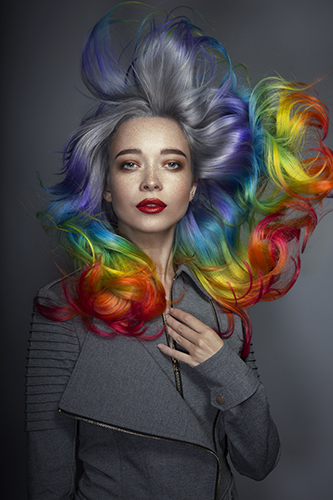Generally, if more melanin is present, the color of the hair is darker; if less melanin is present, the hair is lighter.
The tone of the hair is dependent on the ratio of black or brown eumelanin to yellow or red pheomelanin. Levels of melanin can vary over time causing a person’s hair color to change, and it is possible to have hair follicles of more than one color on the same person. Some hair colors are associated with some ethnic groups due to observed higher frequency of particular hair color within their geographical region, e.g. straight dark hair amongst East Asians, Southeast Asians, Polynesians and Native Americans, a large variety of dark, fair, curly, straight, wavy and bushy hair amongst Europeans, West Asians and North Africans.
Permanent hair color means that the hair’s structure has been chemically altered until it is eventually cut away. This does not mean that the synthetic color will remain permanently. During the process, the natural color is removed, one or more shades, and synthetic color has been put in its place. All pigments wash out of the cuticle. Natural color stays in much longer and artificial will fade the fastest (depending on the color molecules and the form of the dye pigments).
Permanent hair color gives the most flexibility because it can make hair lighter or darker as well as changing tone and color, but there are negatives. Constant (monthly or six-weekly) maintenance is essential to match new hair growing in to the rest of the hair, and to remedy fading. A one-color permanent dye creates a flat, uniform color across the whole head, which can look unnatural and harsh, especially in a fair shade. To combat this, the modern trend is to use multiple colors—usually one color as a base with added highlights or lowlights in other shades.
Semi-permanent color washes out over a period of time—typically four to six weeks, so root regrowth is less noticeable. The final color of each strand is affected by its original color and porosity, so there will be subtle variations in color across the head—more natural and less harsh than a permanent dye. However, this means that gray and white hair will not dye to the same color as the rest of the head (in fact, some white hair will not absorb the color at all). A few gray and white hairs will blend in sufficiently not to be noticeable, but as they become more widespread, there will come a point where a semi-permanent alone will not be enough.
Semi-permanent hair color cannot lighten hair. Hair can only be lightened using chemical lighteners, such as bleach. Bleaching is always permanent because it removes the natural pigment.”Rinses” are a form of temporary hair color, usually applied to hair during a shampoo and washed out again the next time the hair is washed.







Add Comment
You must be logged in to post a comment.